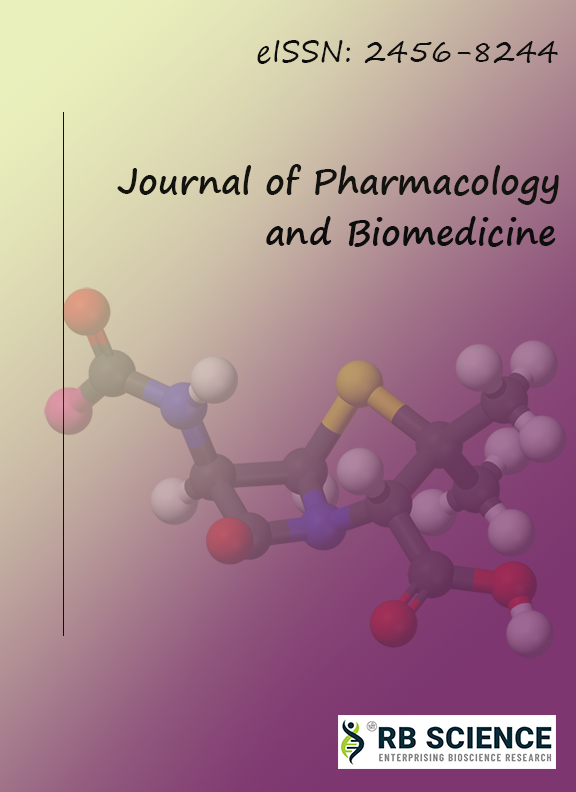
Formulation and evaluation of Repaglinide loaded Nanoparticles
Sailesh Kumar Ghatuary , Reena Shende , Satyawan Dangi , Sarvesh Kumar Shukla , Satkar Prasad ,
ONLINE ISSN : 2456-8244ABSTRACT
Nanoparticles loaded with Repaglinide were prepared using gelatin as the polymeric matrix and glutaraldehyde, PVP, PEG 2000 and PEG 10000 as the cross linking agents. A method of desolvation precipation was used for obtaining the nanoparticles, using acetone as the desolvating agent in each formulation. All the formulations (F1 to F4) were characterized for yield, entrapment efficiency, particle size and in vitro drug release. The order of the particle size obtained using various cross-linking agents was glutaraldehyde < PVP < PEG2000 < PEG 10000. The highest particles size was obtained in F4 (2228.37 nm) while the lowest was in F1 (242.73 nm). The yield of the nanoparticles was also affected by the choice of the cross-linking agent and ranged from 56-74%. The drug entrapment efficiencies of different formulations were in the range of 63.24 to 38.52 %. Glutaraldehyde and PVP were able to sustain the relesae of repaglinide for upto 24 h and 12 h respectively whereas PEG 2000 and PEG 10000 formualations released drug within 8 and 6 h of the study respectively.
KEYWORDS
Repaglinide , Nanoparticles , Desolvation , Gelatin , Release , Entrapment
DOI
REFERENCES
Ahmed O Elzoghby. Gelatin-based nanoparticles as drug and gene delivery systems: Reviewing three decades of research. Journal of controlled release 2013; 172: 1075- 1091. Dass CR, Choong PFM. Carriermediated delivery of peptidic drugs for cancer therapy. Peptides 2006; 27(11): 3020-3028. Gautam N, Mishra A. Formulation and Characterization of Repaglinide Chitosan Nanoparticles for the Treatment of Diabetes Mellitus Type II. Current Research in Pharmaceutical Sciences 2018; .8(4): 270-277. https://www.drugbank.ca/drugs/ DB00912. Assessed on 02/01/2021. Jain SK, Awasthi AM, Jain NK, Agrawal GP. Calcium silicate based microspheres of repaglinide for gastroretentive floating drug delivery: Preparation and in vitro characterization. Journal of Controlled Release 2005; 107: 300- 309. Mali AD, Bathe RS. Development and evaluation of gastroretentive floating tablets of a quinapril HCl by direct compression method. Internat J Pharm Pharm Sci. 2017; 9(8): 35-46. Martin A. Micromeritics. In Physical Pharmacy and Pharmaceutical Sciences: Physical Chemical and Biopharmaceutical Principles in the Pharmaceutical Sciences. 4th edition, 2006; pp. 423-449. Sailaja KA, Amareshwar P, Chakravarty P. Different techniques used for the preparation of nanoparticles using natural polymers and their application. International Journal of Pharmacy and Pharmaceutical Sciences. 2011;3(2): 45-50. Sharma M, Kohli S, Pal A. Preparation and evaluation of controlled release floating microspheres of repaglinide: Optimization and in vitro studies. Asian Journal of Pharmaceutical & Clinical Research 2017; 10(3): 103-107. Srivastava AK, Ridhurkar DN, Wadhwa S. Floating microspheres of cimetidine: Formulation, characterization and in vitro evaluation, Acta Pharmaceutica 2005; 55: 277-285. Wu L, Zhao L, Su X, Zhang P, Ling G. Repaglinide-loaded nanostructured lipid carriers with different particle sizes for improving oral absorption: preparation, characterization, pharmacokinetics, and in situ intestinal perfusion. Drug Delivery 2019; DOI:10.1080/10717544.2019.1689313


